Meditation might seem intimidating at first—especially if you picture it as something only practiced by monks or yoga gurus in total silence. But the truth is, mindfulness meditation is simple, approachable, and accessible to everyone. You don’t need a cushion, a candle, or hours of free time to start reaping the benefits. All you need is a few minutes and a willingness to try.
If you’ve been curious about meditation but unsure how to begin, this beginner’s guide will walk you through everything you need to know to start your own practice—no experience necessary.
What Is Mindful Meditation?
Mindful meditation is a mental practice that helps you become more aware of the present moment. It involves observing your thoughts, emotions, and physical sensations without judgment. Instead of trying to “empty your mind” (a common misconception), mindfulness is about noticing what’s happening right now with openness and curiosity.
This kind of meditation can help reduce stress, increase focus, improve emotional regulation, and even promote better sleep. Best of all? You can do it anywhere—whether you’re sitting at your desk, lying in bed, or walking outside.
Start Small: Just a Few Minutes a Day
One of the biggest mistakes beginners make is thinking they need to meditate for 30 minutes or more to see results. In reality, even a short, consistent daily practice can make a noticeable difference over time.
Begin with just 3 to 5 minutes a day. Set a timer and find a quiet place where you won’t be interrupted. Sit comfortably—on a chair, the floor, or even your bed—and rest your hands gently in your lap. You can close your eyes or keep them slightly open with a soft gaze.
Think of it like brushing your teeth: it’s a small habit that supports long-term well-being, and it gets easier with routine.
Focus on Your Breath
The breath is one of the most common anchors for mindfulness because it’s always with you and constantly changing. As you begin your practice, bring your attention to the natural rhythm of your breath.
Notice the sensation of air entering and leaving your nostrils, or how your chest and belly rise and fall. You don’t need to control or change your breathing—just observe it.
Your mind will wander. That’s normal. When it does, gently bring your focus back to the breath without self-judgment. That returning is where the magic happens—it’s how you train your attention and build mental resilience.
Try a Guided Meditation
If sitting in silence feels too daunting at first, guided meditations can be a great entry point. These recordings walk you through the process with calming instructions, helping you stay focused and relaxed. You can find free guided meditations on apps like Insight Timer, Headspace, Calm, or even YouTube.
Choose one that fits your mood and time frame. Some focus on stress relief, others on gratitude, sleep, or self-compassion. The key is to find a voice and style that feels comfortable for you.
Make It a Habit, Not a Chore
The benefits of meditation build over time, so consistency matters more than duration. Rather than forcing yourself into a long session once a week, try making meditation a regular (and realistic) part of your day.
You might try:
-
Meditating right after waking up to set a calm tone for the day
-
Taking a mindful pause during a lunch break
-
Doing a quick evening meditation to unwind before bed
Linking your meditation to an existing routine—like brushing your teeth or having coffee—can help reinforce the habit.
Let Go of Perfection
There’s no such thing as “failing” at meditation. You won’t always feel calm. Some days will be easier than others. The goal isn’t to stop thinking—it’s to notice your thoughts without getting swept away by them.
Be patient with yourself. Like any new skill, it takes time and practice. The important thing is to show up with curiosity and kindness, even if your mind feels scattered or restless.
A Simple Practice with Profound Benefits
Mindful meditation doesn’t require fancy tools or special training. It’s a simple, grounding practice that anyone can learn—and one that can have a big impact on how you feel, think, and relate to the world around you.
Whether you’re looking to reduce stress, improve focus, or just find a few moments of calm in your day, mindfulness is a powerful tool. And it all starts with one breath, one moment, one decision to be present.

